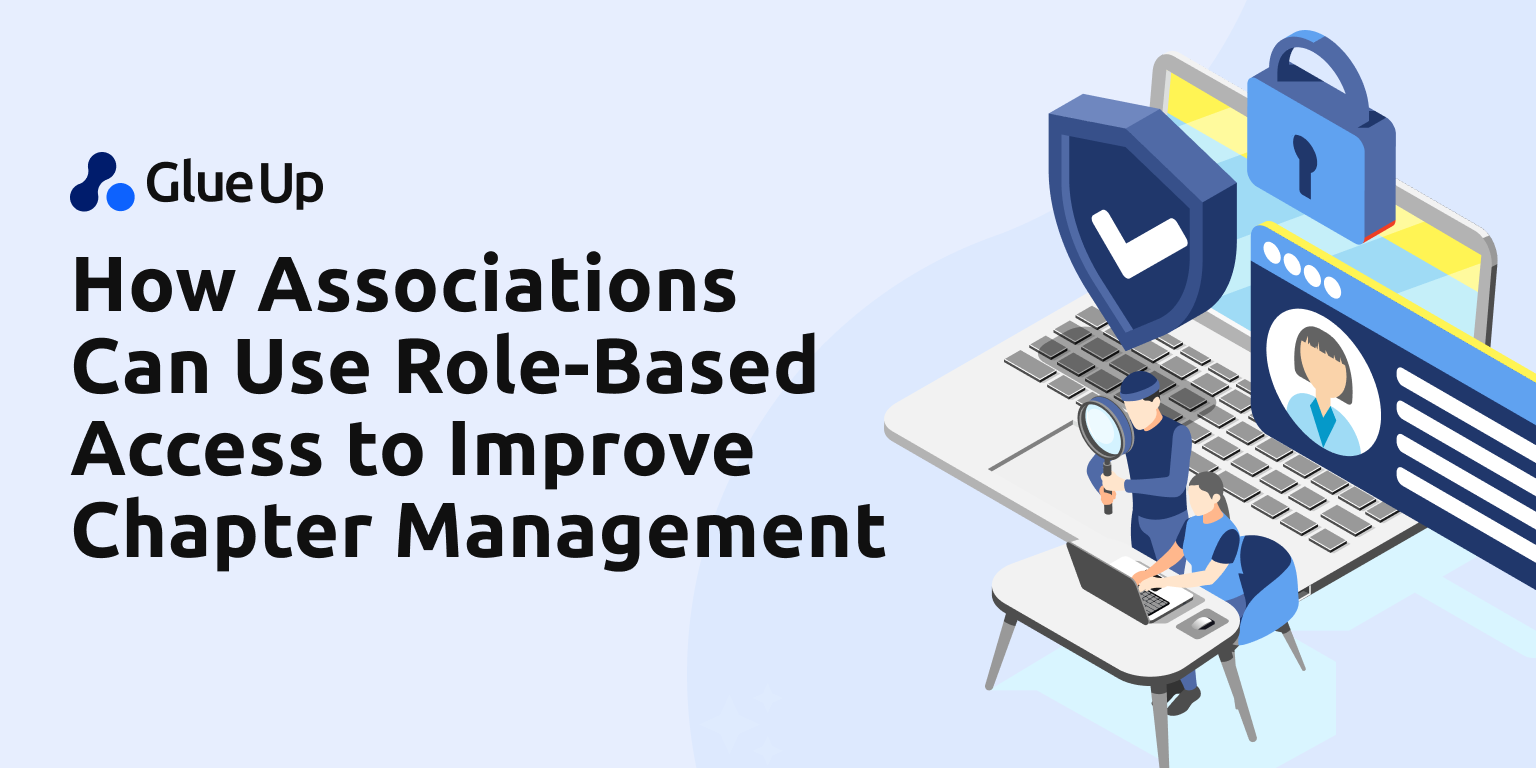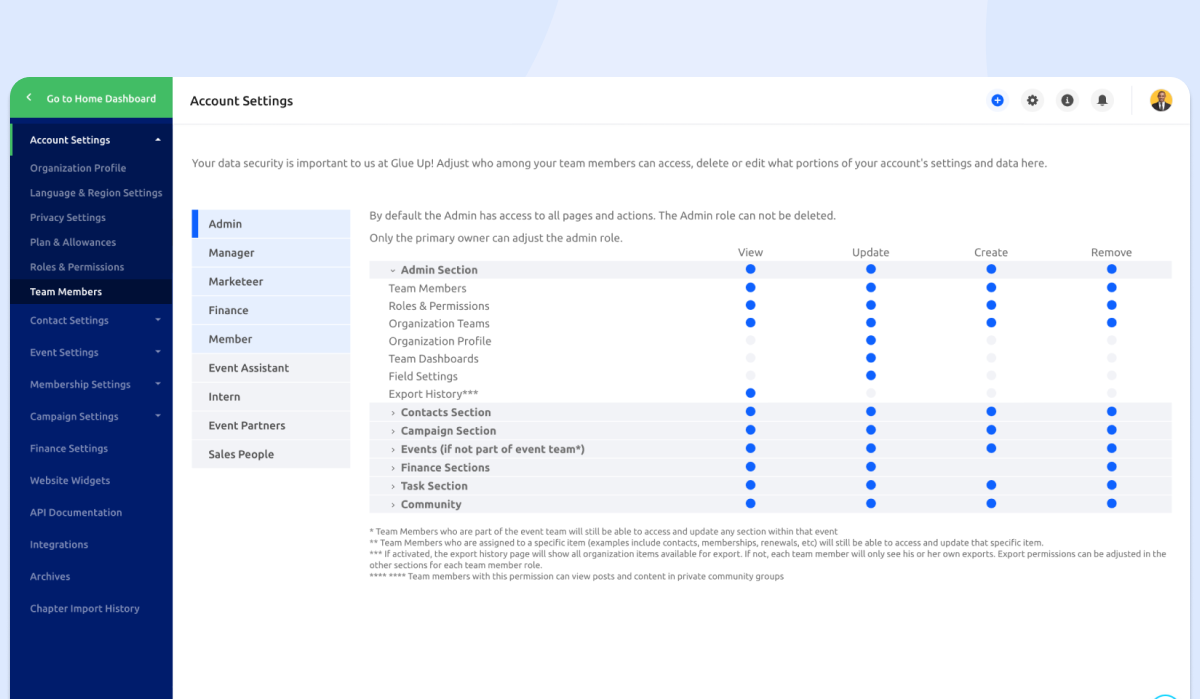
If your organization has multiple chapters in different locations, giving everyone unrestricted access is neither practical nor secure.
Role-based access makes sure individuals only see and use the tools and data relevant to their roles. This access also helps operations run smoothly and protects sensitive information.
Implementing role-based access isn’t just about limiting access. It’s more about careful planning and strategy. You need to set up a system that assigns roles, keeps tasks clearly defined, improves accountability, and avoids overlap.
Want to know how to make role-based access work for your association? Read the blog to explore actionable steps and tools to optimize chapter management!
Key Takeaways
- Role-based access guarantees that individuals only access the tools and data relevant to their roles, leading to smoother operations, minimized overlaps, and enhanced security.
- Role-based access limits unauthorized access protects sensitive data, and supports compliance with regulations like GDPR or HIPAA, reducing risks of breaches and ensuring data integrity.
- This approach easily adapts to new chapters, roles, and members, maintaining operational clarity and consistency even as the organization grows.
- Effective role-based access relies on clearly defined roles, regular reviews of access rights, staff training, chapter performance monitoring, and feedback systems to refine the framework.
- Glue Up’s all-in-one solution supports role-based access by offering tailored role assignments, chapter-specific management, centralized oversight, and scalability, ensuring associations operate securely and efficiently.
Role-Based Access Control in Associations
Role-based access control (RBAC) is a structured approach to delegating responsibilities. It makes certain that individuals have access only to the tools and data they need to perform their roles effectively.
RBAC revolves around assigning the right tasks to the right people based on their qualifications and expertise. For example:
- Finance Manager: Oversees financial operations like budgeting, expense tracking, and dues collection.
- Event Organizer: Plans and manages events, creates attendee lists, and communicates with participants.
- Administrator: Maintains membership databases, processes approvals, and monitors overall operations.
- Chapter Leader: Guides chapter activities, oversees local initiatives and aligns with regional or national goals.
This system creates a clear hierarchy and boundaries and guarantees that everyone knows their role and operates within a defined scope.
The Core Principles of RBAC
RBAC is built on three primary principles:
- Role Definition: You need to clearly outline the responsibilities and permissions for each role. For example, a chapter leader might access regional data, while a community manager focuses only on member engagement.
- Access Limitation: Restrict access to sensitive data or tools based on necessity. For example, financial data might only be accessible to accounting personnel.
- Alignment Across Chapters: You can standardize roles as well across all chapters to maintain consistency while allowing flexibility to adapt to local needs.
Key Benefits of Role-Based Access

Role-based access provides distinct advantages to associations and organizations, making it a vital component for effective chapter management.
The Role-Based Access Control Market is expected to grow from USD 8.7 billion in 2022 to USD 15.5 billion by 2027 at a CAGR of 12.2%. This growth highlights its importance and the numerous advantages it offers, including:
Clarity of Roles and Responsibilities
RBAC removes confusion and prevents overlapping of responsibilities. As per studies, employees who experience role clarity are 53% more efficient and 27% more effective, leading to an overall work performance increase of 25%.
Smooth operations are certified without unnecessary interference, allowing tasks to be completed efficiently. For instance, a finance expert who oversees financial matters without input from unrelated departments will maintain focus and perform better.
Authority and Expertise
When you assign roles to individuals with relevant expertise, it allows them to take ownership of their domains.
Decisions become more informed and beneficial for the association, as an event manager would plan and execute the events without taking instructions from irrelevant departments like membership management or community management.
Time Efficiency
Clearly defined roles help everyone in your team understand their tasks and complete them promptly. Parallel tasks progress without disruptions, which saves time and boosts productivity.
Improved Security
Role-based access limits who can view and modify sensitive data, protecting member information, financial records, and operational details. Considering that it takes organizations an average of 204 days to identify a data breach and 73 days to contain it, restricting access significantly reduces vulnerabilities.
Additionally, 86% of data breaches involve the use of stolen credentials, making it critical to grant access only to authorized individuals.
Streamlined Operations
A clear hierarchy and assigned roles reduce internal conflicts and create a seamless process. This clarity promotes a productive and harmonious work environment.
Scalability
As associations expand, role-based access easily accommodates new chapters, roles, and team members without disrupting the existing structure.
Compliance with Regulations:
When you adhere to regulations like GDPR or HIPAA, it becomes easier to restrict access to authorized individuals.
73% of organization leaders agree that cyber and privacy regulations are effective in reducing their organizations’ cyber risks, highlighting the value of compliance in safeguarding associations.
Ease of Auditing and Reporting
Defined roles facilitate tracking actions and report generation, enhancing accountability. These features are particularly useful during audits or when presenting data to stakeholders.
Improved Member Experience
Efficient internal processes directly improve the member experience. Issues are resolved quickly, events are managed effectively, and financial records remain accurate, creating a positive impression.
Data Integrity and Revenue Clarity:
Accurate data handling and transparent revenue streams significantly reduce errors or mismanagement.
Implementing Role-Based Access: Best Practices

To implement role-based access control (RBAC) effectively in your association, several best practices should be followed:
Define Roles and Responsibilities
Outline what each person will do, and make sure everyone sticks strictly to their assigned tasks and domain. Document these roles or publish them so the concerned people are fully aware of their responsibilities.
Review and Update Access Rights Regularly
Roles should be reviewed frequently to confirm they are being executed effectively. Evaluate whether there are any inconveniences and confirm that everything is proceeding as planned.
Train Staff for RBAC Compliance
Teach your staff how to operate within the access control framework and remain within their designated responsibilities.
Track Chapter Performance and Resources
The performance of chapters should be evaluated to identify areas requiring attention. Assign the best people to highly active chapters with significant queries and activities and use analytics to make informed decisions about resource allocation.
Establish Feedback Mechanisms
A feedback system should be created to allow users to provide input on the system. This helps adapt and improve the framework based on their experiences.
Following these practices helps your association maintain clarity, improve efficiency, and support a well-structured management system.
Glue Up’s Role-Based Access Support

Glue Up is an all-in-one chapter management solution designed to simplify role-based access for associations managing multiple chapters.
The platform provides a hierarchical structure that connects chapters to the umbrella organization while maintaining operational clarity and efficiency.
Hierarchical Organization Structure
Glue Up offers a structured framework in which chapters function independently while remaining aligned with the organization’s overarching goals. This approach streamlines operations and confirms consistency across all chapters.
Chapter-Specific Admins and Teams
Each chapter benefits from its own admin and dedicated team members, with roles tailored to specific responsibilities. For example, chapter admins handle day-to-day operations, event organizers manage local activities, and finance officers focus on budgets.
Role Assignments and Access Control
Glue Up allows tailored role assignments, giving team members access only to the tools and data they need. This feature enhances security and reduces confusion by restricting unnecessary access.
Central Oversight with Local Flexibility
The platform provides centralized oversight for the umbrella organization alongside localized management capabilities. This combination promotes effective monitoring and guarantees that chapters operate efficiently without direct intervention.
Scalable Solution for Growing Organizations
Glue Up adapts to accommodate the needs of growing associations. New chapters, roles, and team members can be added effortlessly while keeping operations seamless and productive.
Glue Up empowers associations to implement role-based access effectively, promoting organized, secure, and efficient chapter management.
Book a demo today to explore how Glue Up can streamline your chapter management and create a structured, well-organized system for your organization.



